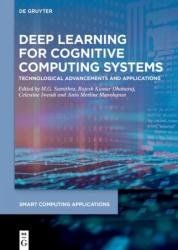 Название: Deep Learning for Cognitive Computing Systems: Technological Advancements and Applications
Название: Deep Learning for Cognitive Computing Systems: Technological Advancements and ApplicationsАвтор: M.G. Sumithra, Rajesh Kumar Dhanaraj, Celestine Iwendi
Издательство: De Gruyter
Год: 2023
Страниц: 214
Язык: английский
Формат: pdf (true), epub
Размер: 85.9 MB
Cognitive computing simulates human thought processes with self-learning algorithms that utilize data mining, pattern recognition, and natural language processing (NLP). The integration of Deep Learning (DL) improves the performance of Cognitive computing systems in many applications, helping in utilizing heterogeneous data sets and generating meaningful insights.
The area of Artificial Intelligence (AI) is the study of how machines execute the tasks which could be completed with the help of human brilliance or intelligence . AI is an advanced area of computing technology that enables a computer or a machine’s critical thinking ability as an intelligent person’s brain. AI can be defined as a collective study of the processes by which the human brain reads the problem, gets knowledge on problems, finds the ways to solve the problems, takes decisions to find the best way, and executes the tasks to achieve the solution.
AI’s major goal is to improve computing’s functions to the level of a human brain by adding activities like thinking, learning, and problem solving. The intelligence is difficult to describe or measure and it is capable of doing the functions like reasoning, learning, problem solving, perception, and linguistic intelligence. Machine Learning makes use of various methods from science and statistical studies such as artificial neural networks, physics, numerical data analysis, and analytical study of problem-solving and decision-making to understand concealed facts in data without any explicit instruction where to search or what to deal. Artificial neural network (ANN) is a similar style of machine learning that is stimulated by a person’s brain’s activities. In neural network, the system is made up of interdependent units (as neurons in brain) that are responsible to manipulate information by reacting to external inputs. Deep Learning uses a large neural network in which the data is processed through multiple layers. Deep learning becomes much feasible as the computing power and training techniques are much improved that makes learning the difficult patterns much easier when dealing with huge datasets. Deep learning refers to a computing idea by which the machines can perform the required tasks smartly.
Recent advancements in Machine Learning have enhanced the features several applications. One such field is the computer vision (CV). The recent times have seen the deployment of robots in many industries and household. Vision for robots or robotic vision is also an emerging field of research. CV can be characterized as a set of errands that incorporate styles for obtaining, deciding, taking apart and grasping computerized pictures, and parentage of high-layered information from this present reality to deliver mathematical or authentic information, for example, in the types of liberations. Understanding in this contexture implies the transformation of visual pictures (the contribution of the retina) into portrayals of the world that appear to be legit to concentrate on processes and can inspire relevant activity. This picture understanding should be visible as the unraveling of significant data from picture information utilizing models developed with the guide of figure, medications, insights, and learning recommendation. The logical discipline of CV is worried about the speculation behind counterfeit frameworks that wine tool data from pictures.
Скачать Deep Learning for Cognitive Computing Systems: Technological Advancements and Applications